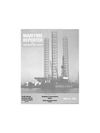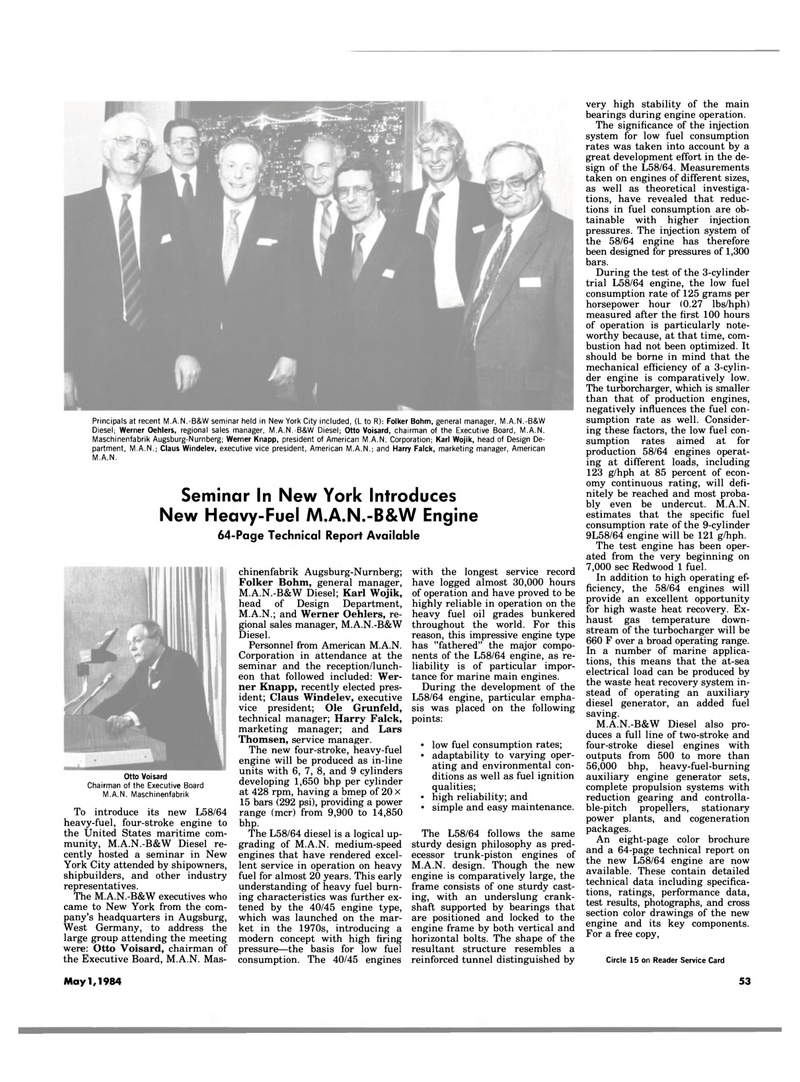
Page 49: of Maritime Reporter Magazine (May 1984)
Read this page in Pdf, Flash or Html5 edition of May 1984 Maritime Reporter Magazine
Principals at recent M.A.N.-B&W seminar held in New York City included, (L to R): Folker Bohm, general manager, M.A.N.-B&W
Diesel; Werner Oehlers, regional sales manager, M.A.N.-B&W Diesel; Otto Voisard, chairman of the Executive Board, M.A.N.
Maschinenfabrik Augsburg-Nurnberg; Werner Knapp, president of American M.A.N. Corporation; Karl Wojik, head of Design De- partment, M.A.N.; Claus Windelev, executive vice president, American M.A.N.; and Harry Falck, marketing manager, American
M.A.N.
Seminar In New York Introduces
New Heavy-Fuel M.A.N.-B&W Engine 64-Page Technical Report Available
Otto Voisard
Chairman of the Executive Board
M.A.N. Maschinenfabrik
To introduce its new L58/64 heavy-fuel, four-stroke engine to the United States maritime com- munity, M.A.N.-B&W Diesel re- cently hosted a seminar in New
York City attended by shipowners, shipbuilders, and other industry representatives.
The M.A.N.-B&W executives who came to New York from the com- pany's headquarters in Augsburg,
West Germany, to address the large group attending the meeting were: Otto Voisard, chairman of the Executive Board, M.A.N. Mas- chinenfabrik Augsburg-Nurnberg;
Folker Bohm, general manager,
M.A.N.-B&W Diesel; Karl Wojik, head of Design Department,
M.A.N.; and Werner Oehlers, re- gional sales manager, M.A.N.-B&W
Diesel.
Personnel from American M.A.N.
Corporation in attendance at the seminar and the reception/lunch- eon that followed included: Wer- ner Knapp, recently elected pres- ident; Claus Windelev, executive vice president; Ole Grunfeld, technical manager; Harry Falck, marketing manager; and Lars
Thomsen, service manager.
The new four-stroke, heavy-fuel engine will be produced as in-line units with 6, 7, 8, and 9 cylinders developing 1,650 bhp per cylinder at 428 rpm, having a bmep of 20 x 15 bars (292 psi), providing a power range (mcr) from 9,900 to 14,850 bhp.
The L58/64 diesel is a logical up- grading of M.A.N, medium-speed engines that have rendered excel- lent service in operation on heavy fuel for almost 20 years. This early understanding of heavy fuel burn- ing characteristics was further ex- tened by the 40/45 engine type, which was launched on the mar- ket in the 1970s, introducing a modern concept with high firing pressure—the basis for low fuel consumption. The 40/45 engines with the longest service record have logged almost 30,000 hours of operation and have proved to be highly reliable in operation on the heavy fuel oil grades bunkered throughout the world. For this reason, this impressive engine type has "fathered" the major compo- nents of the L58/64 engine, as re- liability is of particular impor- tance for marine main engines.
During the development of the
L58/64 engine, particular empha- sis was placed on the following points: • low fuel consumption rates; • adaptability to varying oper- ating and environmental con- ditions as well as fuel ignition qualities; • high reliability; and • simple and easy maintenance.
The L58/64 follows the same sturdy design philosophy as pred- ecessor trunk-piston engines of
M.A.N, design. Though the new engine is comparatively large, the frame consists of one sturdy cast- ing, with an underslung crank- shaft supported by bearings that are positioned and locked to the engine frame by both vertical and horizontal bolts. The shape of the resultant structure resembles a reinforced tunnel distinguished by very high stability of the main bearings during engine operation.
The significance of the injection system for low fuel consumption rates was taken into account by a great development effort in the de- sign of the L58/64. Measurements taken on engines of different sizes, as well as theoretical investiga- tions, have revealed that reduc- tions in fuel consumption are ob- tainable with higher injection pressures. The injection system of the 58/64 engine has therefore been designed for pressures of 1,300 bars.
During the test of the 3-cylinder trial L58/64 engine, the low fuel consumption rate of 125 grams per horsepower hour (0.27 lbs/hph) measured after the first 100 hours of operation is particularly note- worthy because, at that time, com- bustion had not been optimized. It should be borne in mind that the mechanical efficiency of a 3-cylin- der engine is comparatively low.
The turborcharger, which is smaller than that of production engines, negatively influences the fuel con- sumption rate as well. Consider- ing these factors, the low fuel con- sumption rates aimed at for production 58/64 engines operat- ing at different loads, including 123 g/hph at 85 percent of econ- omy continuous rating, will defi- nitely be reached and most proba- bly even be undercut. M.A.N, estimates that the specific fuel consumption rate of the 9-cylinder 9L58/64 engine will be 121 g/hph.
The test engine has been oper- ated from the very beginning on 7,000 sec Redwood 1 fuel.
In addition to high operating ef- ficiency, the 58/64 engines will provide an excellent opportunity for high waste heat recovery. Ex- haust gas temperature down- stream of the turbocharger will be 660 F over a broad operating range.
In a number of marine applica- tions, this means that the at-sea electrical load can be produced by the waste heat recovery system in- stead of operating an auxiliary diesel generator, an added fuel saving.
M.A.N.-B&W Diesel also pro- duces a full line of two-stroke and four-stroke diesel engines with outputs from 500 to more than 56,000 bhp, heavy-fuel-burning auxiliary engine generator sets, complete propulsion systems with reduction gearing and controlla- ble-pitch propellers, stationary power plants, and cogeneration packages.
An eight-page color brochure and a 64-page technical report on the new L58/64 engine are now available. These contain detailed technical data including specifica- tions, ratings, performance data, test results, photographs, and cross section color drawings of the new engine and its key components.
For a free copy,
Circle 15 on Reader Service Card
May 1,1984 53

 48
48

 50
50
